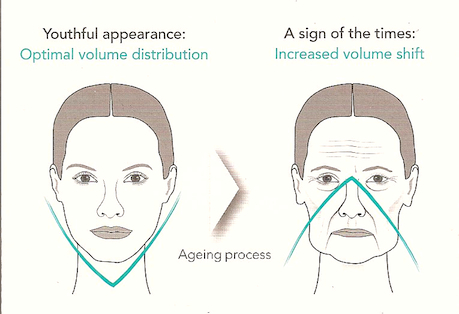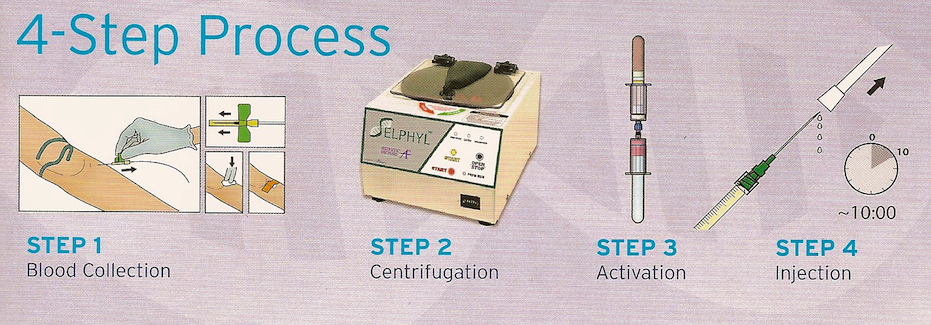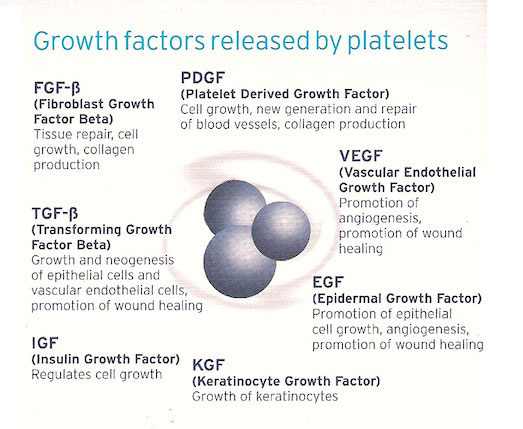The Three D’s of Aging
Deterioration:
- Thinning, dry skin with fine lines and wrinkles.
- Uneven brown pigmentation, texture changes such as coarse pores.
- Accelerated by sun tanning, stress, and exposure to toxins such as cigarette smoke. Some lines are the direct result of habitual expressions, (frowning, squinting, scowling, wrinkling the nose, pursing the lips) and are known as dynamic lines.
best addressed by muscle relaxing agents such as Botox CosmeticTM (see section on Botox).
Deflation
- Shrinkage of the deep fat compartments in the mid face and temples.
Descent
Sagging of the face and neck, which manifests in deep folds, jowls and loose neck tissue.
This is best addressed by the use of volumizing fillers such as Juvederm, Radiesse and Sculptra
Hyaluronic acid is naturally present in our skin, we produce less of it as we age. The hyaluronic acid in Juvederm is not animal-derived, the strands are cross-linked for increased longevity.
Hyaluronic Acid Based Fillers:
Juvederm Ultra
- Used for filling in depressions such as marionette lines and nasolabial folds.
- Will last an average of 10 months.
- It is also used for lip augmentation because the lips are very vascular, its effects in this area are less noticeable after 6 months.
- It is available in a premixed form with 3% lidocaine (a numbing agent) for added comfort Juvederm Ultra XC, or plain (without lidocaine) for persons who may have an allergy to localised anaesthetic.

Juvederm For Lips * Individual Results May Vary
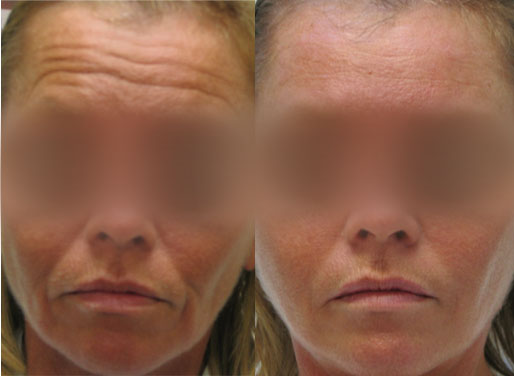
Botox Forehead Lines, Juvederm Smile Lines * Individual Results May Vary
Juvederm Voluma
- A longer-lasting version which is formulated to hold its shape.
- Used by experienced injectors to create volume and lift in the midface and temples.
- Used in the pre-jowl area to round the jaw and disguise the appearance of jowls.
When injecting the lips, the patient may opt for a dental block (a separate injection of lidocaine to completely anaesthetize the infraorbital and mental nerves).
Other areas of the face that can be treated with Juvederm – fine lines above the lips, tear troughs, frown lines between the brows, jawline, temples.
The combination effect of Botox (used for dynamic lines) and Voluma is known as a SoftLift. If done correctly, can give a very nice, natural looking rejuvenating effect.
Hyaluronic Acid Fillers can be broken down by the naturally occurring enzyme, hyaluronidase.
Botox & Juvederm Softlift * Individual Results May Vary Experienced physician injectors will respect naturally occurring anatomical proportions, and will avoid over-stuffed cheeks, distorted, protruding lips and frozen faces that can be seen as a result of over zealous treatment by injectors with less rigorous training in anatomy. 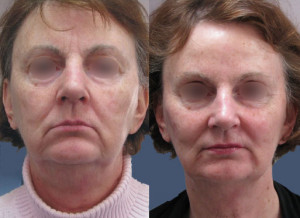
Sculptra
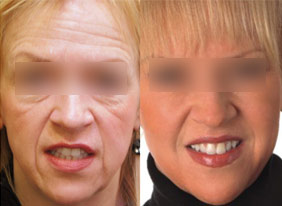
Sculptra * Individual Results May Vary
What is Sculptra?
Sculptra is made from Poly-L-Lactic acid, a compound commonly used in surgical sutures for its collagen-stimulating properties. It is mostly used for pronounced facial volume loss and sagging, due to subcutaneous and deep facial compartment fat loss. This can occur in association with rapid weight loss, as well as the muscle atrophy and bone resorption that occur naturally with aging. It was also the first filler to be approved by the FDA and Health Canada for severe localised loss of fat tissue related to HIV
Areas which can be treated include the cheeks, nasolabial folds, jawline, chin, marionette lines and temples.
One of the interesting side benefits of this product is its phenomenal ability to rejuvenate the skin, rendering it baby-soft, smooth and glowing, due to its powerfully stimulating effect on collagen production.
How Does It Differ From Fillers Such As Juvederm?
Sculptra differs in its onset of action to Juvederm. Immediately following injections the volume loss is replenished; over the next few weeks, the initial effect diminishes, to be followed by a third phase coinciding with the stimulation of natural collagen in which the volume is gradually regained.
Because of this 3 stage process, a full Sculptra treatment is usually administered over 2-4 sessions, spread out over a 2-6 month period. The end result will last in excess of 2 years. It is commonly referred to as the Liquid Facelift in France.
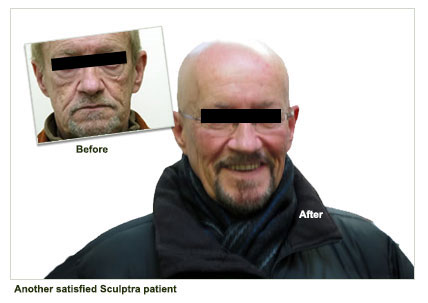
* individual results will vary
* individual results will vary
Regarding this gentleman, we started with microdermabrasion to freshen up the skin; followed by a series of Sculptra treatments to the midface and periorbital regions, followed by one Accent XL laser skin tightening treatment to the forehead region – to reduce forehead wrinkling and elevate brows slightly – (a little Sculptra was also used under the brow to enhance this effect) resulting in a happier, rejuvenated appearance.
See also featurette: St John’s Woman tells her Story
Replenish Volume
The V -Effect
When we are young, the subcutaneous fat padding the cheekbones acts as a scaffold supporting the midface. The broadest area is at the cheekbones, coming to a soft V at the chin. With advancing years, the loss of elasticity and subsequent sagging of facial tissue allows the skin to fall down in folds, creating a broad, square effect at the chin creating the reverse V effect. The idea of placing fillers or injectable implants over the cheekbones is to recreate this scaffold, and thus “lift” the face back to a more youthful contour.
Radiesse
Typical uses are for providing lift for mid-face sagging and jowls. It is the only filler approved by Health Canada for hand rejuvenation. It can also be used in the nasal bridge to improve the nose profile (5 min non-surgical rhinoplasty)
-

* Individual Results May Vary
Composed of Calcium hydroxyapatite micro spheres in a methylcellulose base; it provides instant volume and also stimulates collagen production, which gives it a longer lasting effect than the usual hyaluronic acid based fillers.
- Areas injected are cheeks, pre and post jowls, marionette lines, nasolabial folds, temples, nasal bridge and backs of the hands.

* Individual Results May Vary
Selphyll
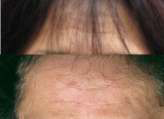
forehead lines before and after Selphyl *Individual Results Will Vary
Selphyll represents a leap forward into true regenerative medicine. By harnessing the power of your own biology (in this case the growth factors attached to your own platelets) to stimulate the growth of new skin cells to fill in hollows, scars and fine lines of the face, neck and hands.
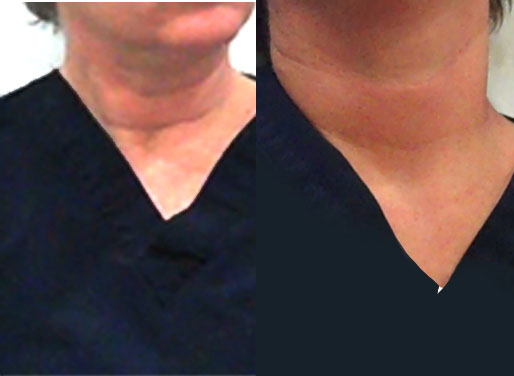
Selphyl For Neck Rings * Individual Results May Vary
Unlike conventional dermal fillers, no foreign material is injected into your body. in a simple 4 stage process, a small amount of your own blood is withdrawn, spun in a centrifuge to separate the red and white blood cells from the serum containing your platelets. The serum is then activated to produce Platelet Rich Fibrin Matrix (PRFM), which is then injected back into the areas requiring correction. Typically fine lines, acne scars, hollows under the eyes, and other difficult-to-treat areas such as horizontal neck rings, backs of the hands, or creases on the chest wall and as an adjunct in full-face resurfacing.
Over the next 6-12 weeks, your body will do the rest regarding tissue repair and cellular growth. Collagen production will proceed to fill in the hollows and lines naturally. The advantages of this process are virtually no chance of allergic reaction; gradually emerging natural results; and – because it is your own tissue vs. a foreign substance which could be broken down by enzymes in the body- long lasting effects!!
The advantages of this process are:
- Virtually no chance of allergic reaction
- Gradually emerging natural results
- Because it is your own tissue vs. a foreign substance which could be broken down by enzymes in the body you will have a long lasting result.
Selphyll- Adapting the natural process of wound healing for cosmetic indications
What Happens When We Cut Ourselves?
A gap is created in our skin, we bleed, the blood clots, and over a period of weeks, the body creates new cells to fill in the gap and knit the edges of the wound together.
Why Do We Stop Bleeding?
The platelets in our blood clump together, producing fibrin, which, together with the platelets, forms the clot, or plug to stop the bleeding.
This Platelet-Rich Fibrin Matrix (aka the “clot”) forms the scaffold over which new cells (eg. fibroblasts, epidermal cells and vascular cells) grow, eventually filling in the gap and remodelling the skin to heal the wound.
What Triggers This New Cellular Growth?
At least 7 major growth factors attached to platelets have been identified to be responsible for tissue repair.
Platelet Rich Fibrin Matrix (PRFM) has been successfully used in other clinical applications such as:
- Oral-Maxillofacial Surgery (e.g. implant surgery)
- Sports Medicine (eg. tendon repair)
- Wound Care
Frequently Asked Questions
Are There Any Contraindications to PRFM (Selphyll)?
PRFM injections are contraindicated to the following
- In areas of a localized infection.
- In persons subject to hypertrophic scarring (keloids).
- In persons with auto-immune disease.
- If anaemia is present.
- In persons with intrinsic disorders of platelets or clotting function (eg. Factor V Leiden).
- In persons taking medications that may affect platelet function (eg. ASA, Anti-Inflammatory Medication, Plavix, Warfarin etc).
- In pregnant or breast-feeding women.
Is There Risk Of Fibrotic Tissue Forming In The Skin After Injection?
Currently, there are no reports regarding hardening/lumps or bumps. A slow release of growth factors occurs over time, which would disfavour the formation of a fibrous mass; The PRFM itself has a gelatinous structure, which will be resorbed over time, as the new epithelial cells grow.
What Is The Vampire Facelift?
The Vampire Facelift was a term coined by the American media to describe a technique used by some plastic surgeons to mix the patient’s platelets or mesenchymal stem cells with fat cells extracted from their body during liposuction and re-inject it in the midface to create a lift , much as we now use volumizing fillers such as Radiesse or Voluma.
